Surgical drape
a surgical and drapery technology, applied in the field of surgical drapes, can solve the problems of affecting the effectiveness of the sterility maintenance cover, substantial risk that the drape or a portion of it will move, and increasing the risk of infection, so as to facilitate the access to the patient's head and facilitate the patient's head
- Summary
- Abstract
- Description
- Claims
- Application Information
AI Technical Summary
Benefits of technology
Problems solved by technology
Method used
Image
Examples
Embodiment Construction
Referring now to FIG. 1, an exemplary sterility maintenance cover for use in connection with a surgical drape according to the present invention is conceptually shown. The sterility maintenance cover generally includes (i) a base panel 130 for fitting under the head, neck and shoulders of a patient positioned on an examination or operating table, (ii) an upward-standing end panel 120 extending from the base panel and having an open window 140 for accessing the patient from the head-end of the table, and (iii) a cantilevered platform 110 projecting horizontally from the end panel, substantially parallel to the base panel. Preferably, platform 110 is designed to support a drape over a patient's head and to receive and retain or deploy various instruments used in the procedure.
Now referring to FIG. 2, a top plan view of an exemplary surgical drape 210 in accordance with a preferred embodiment of the present invention is shown. The drape 210 preferably includes an open window 220; trans...
PUM
 Login to View More
Login to View More Abstract
Description
Claims
Application Information
 Login to View More
Login to View More - R&D
- Intellectual Property
- Life Sciences
- Materials
- Tech Scout
- Unparalleled Data Quality
- Higher Quality Content
- 60% Fewer Hallucinations
Browse by: Latest US Patents, China's latest patents, Technical Efficacy Thesaurus, Application Domain, Technology Topic, Popular Technical Reports.
© 2025 PatSnap. All rights reserved.Legal|Privacy policy|Modern Slavery Act Transparency Statement|Sitemap|About US| Contact US: help@patsnap.com



